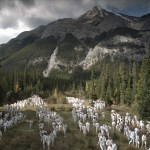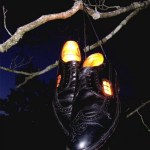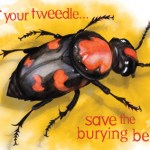
One of my pet peeves is the idea that BMI provides an accurate indication of individual health. It doesn't. It's useful across populations (and may be useful to individuals to monitor progress), but when it comes to indicating which individuals are "healthier", BMI fails miserably - and our new Sciblings at Obesity Panacea do a great job of explaining why.
If, as a policy matter, we want to differentiate between the healthy and unhealthy - which is a big if, depending on how libertarian you are - let's make such assessments meaningfully, using a workout that proves general endurance and…
Only National Geographic would dare cross The Amazing Race with the mystery of conception to get. . . The Great Sperm Race:
Each of us was the grand prize in an ultimate reality competition, the amazing race a sperm makes on the road to fertilization. Millions of sperm compete while overcoming armies of antibodies, treacherous terrain and impossible odds to reach their single-minded goal. To illustrate the full weight of the challenge, Sizing Up Sperm uses real people to represent 250 million sperm on their marathon quest to be first to reach a single egg.
Obviously there aren't 250 million…
By Joseph Hewitt, who clearly understands the Sb atmosphere quite well.
For the annals of humorous translation mistakes, this package from a digital antenna we bought last fall promises to . . . do something. I'm not sure what.
For John O, who enjoys terrible advertising.
The cover of a 1922 issue of Life: it's a visual pun on at least one level, but it's also just pretty!
Update: welcome Consumerist readers! While I use my own experience to illustrate concerns about third-party online merchants, this post is mainly about the bigger long-term informational problems I see with reputation, reliability, and online communities. Please feel free to weigh in!
A few weeks ago, I caught a familiar story on the local news. A local citizen had written in to the news team with a request for help after a local furniture company sold them a defective living room set, and wouldn't give them a refund. The news team went to the business, who - wary of the potential public…
A friend of mine recently turned me on to the great street art blog Wooster Collective. Check out this unexpected street art in Richmond, Virginia: pairs of old shoes dangling in trees seem mundane by day, but by night, they're like streetlamps from a Tim Burton cartoon. Solar panels inside the shoes supply the light. No idea who the creator is.
Check out more stealth art at Wooster Collective.
A blunt animated message for Surfrider's Rise Above Plastics, with Portland's Borders Perrin Norrander (full credits here)
Via Notcot and others.
An interesting post from Repository for Bottled Monsters gathers together a few links on art/exhibit censorship, like this opinion, "Why Some Art Should Be Censored," from the Shreveport Times: "Another sort of case concerns the use of human corpses in art. There is a venerable tradition of showing the dead for various reasons, as in Rembrandt's famous The Anatomy Lesson of Dr. Tulp or Goya's depictions of the horrors of war -- not to mention numerous crucifixions. . . "
Campbell's is redesigning their iconic red-and-white soup packaging. Why? The answer's in your brain - or so they think:
Campbell's said traditional customer feedback wasn't telling the company why soup sales weren't doing so hot. "A 2005 Campbell analysis revealed that, overall, ads deemed more effective in surveys had little relation to changes in sales," the WSJ says.So they turned to "science." Campbell's hired Innerscope Research Inc. to conduct tests on a whopping 40-person sample to see what design elements produced the most "emotional engagement."The team clipped small video cameras…
Google may have done Buzz all wrong, but they do Chrome right in these adorable, Rube Goldberg-style ads.
Jesse ("Jess3") Thomas's brand-new clip, like a slimmed-down, retro-styled, updated cousin of that ubiquitous "Right here, right now" video, is the perfect appetizer to complement the Pew's brand-new report on participatory news. Enjoy.
This may appeal to some of you:
The 15th biannual conference of the European Association of Museums for the History of Medical Sciences (EAMHMS) will be held at the University of Copenhagen, 16-18 September, 2010. This year's conference focuses on the challenge to museums posed by contemporary developments in medical science and technology.The image of medicine that emerges from most museum galleries and exhibitions is still dominated by pre-modern and modern understandings of an anatomical and physiological body, and by the diagnostic and therapeutical methods and instruments used to…
A provocative post over at the Intersection.
I haven't had time to weigh in on the vitriol-slinging because I'm on blogcation - and honestly, the stuff Sheril describes is one of the very reasons I decided to take a blogcation. But knowing that I'll be attacked for saying it, yes, I agree with her that hateful ad hominem attacks are increasing in the science blogosphere, it's nauseating, and it doesn't reflect well on any of us.
From the Center for Biological Diversity, "Endangered Species Condoms":
To help people understand the impact of overpopulation on other species, and to give them a chance to take action in their own life, the Center is distributing free packets of Endangered Species Condoms depicting six separate species: the polar bear, snail darter, spotted owl, American burying beetle, jaguar, and coquà guajón rock frog.
You can even sign up to win a lifetime supply. Whatever that is.
A visualization from NOAA representing the dissipation of energy from the Chilean earthquake.
One of the reasons little liberal arts colleges are awesome: this course at Lafayette. It's part of their Values and Science/Technology Program.
A physicist with a baby iceberg in Qaanaaq, Greenland. (I think its enraged mother is just out of range of the camera, about to crush him.)
Via Armed with Science.
In Cambridge, at a "Wireside chat" on "Fair Use, Politics, and Online Video" by legal scholar, IP expert and corrupt-government critic Lawrence Lessig. He's comparing the addictivity/potential danger of wifi to smoking. Say it ain't so! I need my wifi!
Sad, weird, and odd: a 1kg spectacled owl attacked, killed, and ate (part of) a defenseless three-toed sloth. Apparently the owl stabbed its talons in the sloth's neck while it was on the way to the ground to defecate, and then pecked its organs out. I wish I was kidding.








